
Leggy Birds:
Storks are graceful, lanky birds with long, slender legs. These leggy birds are able to take large strides through deep water and tall grass to find food. Their long necks enable them to lean down to nab the prey by their feet.
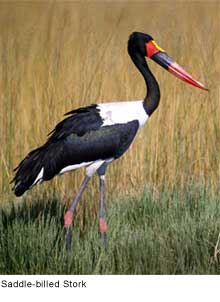 Why Flap? In flight, they are also a sight to behold. Rather than continuously flapping their wings, they fly by soaring on warm air currents. Their long wings only flap occasionally. Because storks fly with their necks outstretched, dangling their legs behind their bodies, they are easy to recognize as they fly above. Why Flap? In flight, they are also a sight to behold. Rather than continuously flapping their wings, they fly by soaring on warm air currents. Their long wings only flap occasionally. Because storks fly with their necks outstretched, dangling their legs behind their bodies, they are easy to recognize as they fly above.
Vultures or Storks? Some species of stork scavenge for food that is already dead. These birds have bald patches on their heads to prevent their feathers from getting covered in mud or blood. These bald spots also enable the birds to communicate to one another! During the breeding season, their patches of featherless skin become brightly colored.

Just the Facts: Storks have no syrinx and are mute, giving no bird call; bill-clattering is an important mode of stork communication at the nest. Many species are migratory. Most storks eat frogs, fish, insects, earthworms, and small birds or mammals. There are 19 species of storks in six genera.
Winging It: Storks tend to use soaring, gliding flight, which conserves energy. Soaring requires thermal air currents. Ottomar Anschütz's famous 1884 albumen photographs of storks inspired the design of Otto Lilienthal's experimental gliders of the late
19th century. Storks are heavy with wide 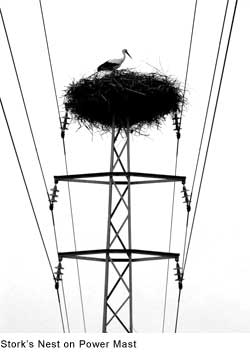 wingspans, and the Marabou Stork, with a wingspan of 3.2 m (10.5 feet), shares the distinction of "longest wingspan of any land bird" with the Andean Condor. wingspans, and the Marabou Stork, with a wingspan of 3.2 m (10.5 feet), shares the distinction of "longest wingspan of any land bird" with the Andean Condor.
Home-birdies: Their nests are often very large and may be used for many years. Some have been known to
grow to over 2 m (6 feet) in diameter and about 3 m (10 feet) in depth. Storks were once thought to be monogamous, but this is only true to a limited extent. They may change mates after migrations, and migrate without them. They tend to be attached to nests
as much as partners.
Famous Bird: Storks' size, serial monogamy, and faithfulness to
an established nesting site contribute
to their prominence in mythology
and culture.

The White Stork
Just the Facts: The White Stork (Ciconia ciconia) is a large wading bird in the stork family Ciconiidae. It is a widespread but declining species which breeds in the warmer parts of Europe but recent sightings and signs of increasing have been found in Britain. It is a strong migrant, wintering in tropical Africa.
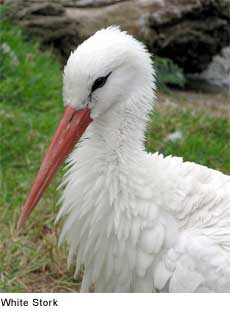 Land Love-birds: This is a broad winged soaring bird, which relies on moving between thermals of hot air for sustained long distance flight. Since thermals only form over land, storks, together with large raptors, must cross the Mediterranean at the narrowest points, and many hundreds can be seen going through the straits of Gibraltar and the Bosphorus. Land Love-birds: This is a broad winged soaring bird, which relies on moving between thermals of hot air for sustained long distance flight. Since thermals only form over land, storks, together with large raptors, must cross the Mediterranean at the narrowest points, and many hundreds can be seen going through the straits of Gibraltar and the Bosphorus.
Huge Bird: The White Stork is a huge bird, 1 m tall with a 2 m wingspan. It is completely white except for the black wing flight feathers and its red bill and legs. It walks slowly and steadily on the ground. Like all storks, it flies with its neck outstretched.
Good Luck Charms: These storks breed in open farmland areas with access to marshy wetlands. It builds a stick nest in trees, on buildings, or special platforms. Because it is viewed as bird of good luck, it is not persecuted, and it often nests close to human habitation. In southern Europe, storks' nests can often be seen on churches and other buildings. It often forms small colonies.
Storks in Danger: The decline in the north of its range may be due to the drainage of wetlands and collisions with overhead power lines. The White Stork is one of the species to which the Agreement on the Conservation of African-Eurasian Migratory Waterbirds (AEWA) applies.
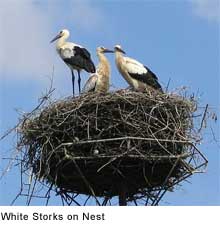 Storks in Eastern Europe: A quarter of the world population of White Stork Storks in Eastern Europe: A quarter of the world population of White Stork
breeds in Poland. Approximately 13,000
White Stork pairs bred in Lithuania, the
fifth largest population and highest known density of this species in the world. But
in Latvia lives around 12,000 White
Stork pairs.
Food For the Birds: The White Stork, like most of its relatives, feeds mainly on frogs and large insects, but also young birds, lizards and rodents.
Mute, But Not Silent: This stork is almost silent except for the noisy mutual bill-clattering when adults meet at the nest.

Stork Symbolism:
Beloved Bird: The white stork is the symbol of The Hague in the Netherlands and the unofficial symbol of Poland, where about 25 percent of European storks breed.
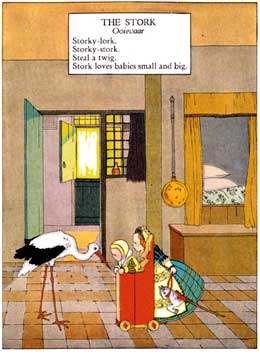 Stork Education: Stork Education:
In Western culture the White Stork is a symbol of childbirth. In
Victorian times the details of human reproduction were difficult to approach, especially in reply to a child's query of "Where did I come from?"; "The stork brought you
to us" was the tactic used to avoid discussion of sex.
This habit was derived from the once popular superstition that storks
were the harbingers of happiness and prosperity.
Stork Bites: The image of a stork bearing an infant wrapped in a sling held in its beak is common in popular culture.
The small pink or reddish patches often found on a newborn child's eyelids, between the eyes, upper lip, and the nape of the neck, which are clusters of developing veins that soon fade, are sometimes still called "stork bites".
Vlasic Pickles: Vlasic brand pickles in North America use this child-bearing stork as a mascot.
-----------------------------------------------------------------------------------------------------------------------------
Mythology of storks: Most of these myths tend to refer to the White Stork.
 Ancient Egypt: In Ancient Egypt the stork was associated with the human ba; they had the same phonetic value. The ba was the unique individual character of each human being: a stork with a human head was an image of the ba-soul, which unerringly migrates home each night, like the stork, to be reunited with the body during the Afterlife. Ancient Egypt: In Ancient Egypt the stork was associated with the human ba; they had the same phonetic value. The ba was the unique individual character of each human being: a stork with a human head was an image of the ba-soul, which unerringly migrates home each night, like the stork, to be reunited with the body during the Afterlife.
Aesops Fables: The motto "Birds of a feather flock together" is appended to Aesop's fable of the farmer and the stork his net caught among the cranes that were robbing his fields of grain. The stork vainly pleaded to be spared, being no crane.
Hebrew: The Hebrew word for stork was equivalent to "kind mother", and the care of storks for their young, in their highly visible nests, made the stork a widespread emblem of parental care. It was widely noted in ancient natural history that a stork pair will be consumed with the nest in a fire, rather than fly and abandon it.
Greek Mythology: In Greek mythology, Gerana was an Æthiope, the enemy of Hera, who changed her into a stork, a punishment Hera also inflicted on Antigone, daughter of Laomedon of Troy (Ovid, Metamorphoses 6.93). Stork-Gerana tried to abduct her child, Mopsus. This accounted, for the Greeks, for the mythic theme of the war between the pygmies and the storks. In popular Western culture, there is a common image of a stork bearing an infant wrapped in cloths held in its beak; the stork, rather than absconding with the child Mopsus, is pictured as delivering the infant, an image
of childbirth.
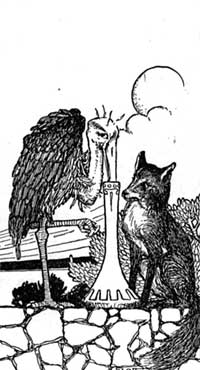 Early Christians: The stork is alleged in folklore to be monogamous although in fact this monogamy is "serial monogamy", the bond lastiong one season: see above. For Early Christians the stork became an emblem of a highly respected "white marriage", that is, a chaste marriage. This symbolism endured to the seventeenth century, as in Henry Peacham's emblem book Minerva Britanna (1612) (see link). Early Christians: The stork is alleged in folklore to be monogamous although in fact this monogamy is "serial monogamy", the bond lastiong one season: see above. For Early Christians the stork became an emblem of a highly respected "white marriage", that is, a chaste marriage. This symbolism endured to the seventeenth century, as in Henry Peacham's emblem book Minerva Britanna (1612) (see link).
Czech: Though "Stork" is rare as an English surname, the Czech surname "C(apek" means "little stork".
China: For the Chinese, the stork was able
to snatch up a worthy man, like the flute-player Lan Ts'ai Ho, and carry him to a blissful life.
Norse Mythology: In Norse mythology,
Hoenir gives to mankind the spirit gift, the óðr that includes will and memory and makes
us human (see Rydberg link). Hoenir's epithets
langifótr "long-leg" and aurkonungr "mire-king" identify him possibly as a kind of stork. Such a Stork King figures in northern European myths and fables. However, it is possible that there is confusion here between the White Stork and the more
northerly-breeding Common Crane, which superficially resembles a stork but is completely unrelated.
Bulgarian Folklore: In Bulgarian folklore, the stork is a symbol of the coming spring (as this is the time when the birds return to nest in Bulgaria after their winter migration) and in certain regions of Bulgaria it plays a central role in the custom of Martenitsa: when the first stork is sighted it is time to take off the red-and-white Martenitsa tokens, for spring is truly come.
South Texas: A series of sightings of a mysterious pterodactyl-like creature in South Texas' Rio Grande Valley in the 1970s has been attributed to an errant giant stork that become lost during a migratory flight and wound up in an unfamiliar region (see Big Bird, Texas).
-----------------------------------------------------------------------------------------------------------------------------
Genera of Stork: There are 19 species of storks in six genera.
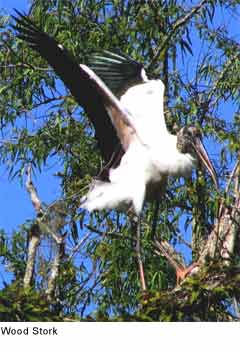 1) Mycteria: Mycteria is a genus 1) Mycteria: Mycteria is a genus
of large tropical storks with representatives in the Americas, east Africa and southern and southeastern Asia. They are broad-winged soaring birds that fly with the neck outstretched and legs extended. They are resident breeders in lowland wetlands with trees in which build large stick nests.
The Mycteria storks are large birds, typically around 90-100 cm in length with a 150 cm wingspan. The
body plumage is mainly white in all the species, with black in the flight feathers of the wings. The Old World species have a bright yellow bill, red or yellow bare facial skin and red legs, but these parts are much duller in the Wood Stork of tropical America.
Juvenile birds are a duller version of the adult, generally browner, and with a paler bill.
These storks walk slowly and steadily in shallow open wetlands seeking their prey, which, like that of most of their relatives, consists of fish, frogs and large insects.
-----------------------------------------------------------------------------------------------------------------------------
2) Anastomus: The openbill storks are two species of stork (family Ciconiidae) in the genus Anastomus. They are large wading birds characterized by large bills, the mandibles of which do not meet except at the tip. This feature develops only in the adults. The two species of openbill storks are:
Asian Openbill Stork (A. oscitans), a resident breeder in tropical southern Asia from India and Sri Lanka east to Southeast Asia.
African Openbill Stork (A. lamelligerus,) a resident breeder in Africa and Madagascar.
-----------------------------------------------------------------------------------------------------------------------------
3) Ciconia: Ciconia is a genus of birds in the stork family. Six of the seven species occur in the Old World, but the Maguari Stork has a South American range.
These are large storks, typically 100 cm tall, with a 180 cm wingspan and a long thick bill. Members of this genus are more variable in plumage than other storks, but several species have black upper bodies and wings, and white belly and undertail. Juveniles are a duller, browner version of the adult.
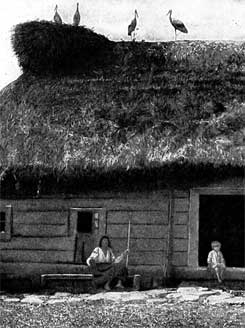 Ciconia storks are gregarious and colonial breeders, and pairs stay together for life. They typically build large stick nests in trees, although the Maguari Stork will nest on the ground and at least three species will construct their nests on human habitations. One of these, the White Stork, is probably the best known of all storks, with a wealth of legend and folklore associated with this familiar visitor to Europe. Ciconia storks are gregarious and colonial breeders, and pairs stay together for life. They typically build large stick nests in trees, although the Maguari Stork will nest on the ground and at least three species will construct their nests on human habitations. One of these, the White Stork, is probably the best known of all storks, with a wealth of legend and folklore associated with this familiar visitor to Europe.
Ciconia storks feed on frogs, insects, young birds, lizards and rodents. They fly with the neck outstretched, like most other storks, but unlike herons which retract their neck in flight.
The migratory species like the White Stork and the Black Stork soar on broad wings and rely on thermals of hot air for sustained long distance flight. Since thermals only form over land, these storks, like large raptors, must cross the Mediterranean at the narrowest points, and many of these birds can be seen going through the Straits of Gibraltar and the Bosphorus on migration.
-----------------------------------------------------------------------------------------------------------------------------
4) Ephippiorhynchus: Ephippiorhynchus is a small genus of storks. It contains two very large birds, more than 140cm tall with a 230-270cm wingspan. Both are mainly black and white, with huge colourful, mainly red and black bills. The sexes of these species are similarly plumaged, but differ in eye color.
The species are:
Saddle-billed Stork: Ephippiorhynchus senegalensis of sub-Saharan Africa
Black-necked Stork: Ephippiorhynchus asiaticus of tropical Asia
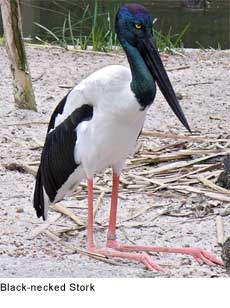 These large wading birds breed in marshes and other wetlands, building a large, deep stick nest in a tree. Like most storks, they fly with the neck outstretched, not retracted like a heron. They are silent except for bill-clattering at the nest. These large wading birds breed in marshes and other wetlands, building a large, deep stick nest in a tree. Like most storks, they fly with the neck outstretched, not retracted like a heron. They are silent except for bill-clattering at the nest.
Ephippiorhynchus storks, like most of their relatives, feeds mainly on fish, frogs and crabs, but also on young birds, and other land vertebrates. They move in a deliberate and stately manner as they hunt, in a similar way to the larger heron.
The genus name Ephippiorhynchus is derived from Greek ephippos, "on a horse", and rhynchus, "bill", and refers to the frontal shield which saddles the bill of one species.
-----------------------------------------------------------------------------------------------------------------------------
5) Jabiru: The Jabiru (Jabiru mycteria) is a large stork found in the Americas from Mexico to Argentina, except west of the Andes. It is most common in the Pantanal region of Brazil and the Eastern Chaco region of Paraguay. It is the only member of the genus Jabiru. The name comes from the Tupi-Guaraní language and means "swollen neck".
The adult Jabiru may be 1.15 m tall, with a 2.60 m wingspan, and may weigh up to 8 kg. The beak, up to 30 cm long, is black and broad, slightly upturned, ending in a sharp point. The plumage is mostly white, but the head and upper neck are featherless and black, with a featherless red stretchable pouch at the base. The sexes are similar, although the female is usually smaller than the male. While it is an ungainly bird on the ground, the Jabiru is a powerful and graceful flier.
The Jabiru lives in large groups near rivers and ponds, and eats prodigious quantities of fish, mollusks, and amphibians. It will occasionally eat reptiles and small mammals. It will even eat fresh carrion and dead fish, such as those that die during dry spells, and thus help maintain the quality of isolated bodies of water.
The nest of twigs is built by both parents around August–September (in the southern hemisphere) on tall trees, and enlarged at each succeeding season. Half a dozen nests may be built in close proximitiy, sometimes among nests of herons and other birds. The parents take turns incubating the clutch of 2 to 5 white eggs.
-----------------------------------------------------------------------------------------------------------------------------
6) Leptoptilos: Leptoptilos is a genus of very large tropical storks. Two species are resident breeders in southern Asia, and the Marabou Stork is found in sub-Saharan Africa.
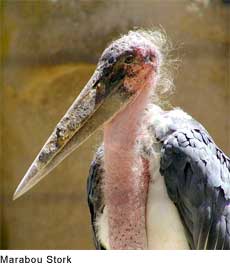 These are huge birds, typically 110-150 cm tall with a 210- 250 cm wingspan. The three species each have a black upper body and wings, and white belly and undertail. The head and neck are bare like those of a vulture. The huge bill is long and thick. Juveniles are a duller, browner version of the adult. These are huge birds, typically 110-150 cm tall with a 210- 250 cm wingspan. The three species each have a black upper body and wings, and white belly and undertail. The head and neck are bare like those of a vulture. The huge bill is long and thick. Juveniles are a duller, browner version of the adult.
Leptoptilos storks are gregarious colonial breeders in wetlands, building large stick nests in trees. They feed on frogs, insects, young birds, lizards and rodents. They are frequent scavengers, and the naked head and neck are adaptations to this, as it is with the vultures with which they often feed.
In each case, a feathered head would become rapidly clotted with blood and other substances when the bird's head was inside a large corpse, and the bare head is easier to keep clean.
Most storks fly with neck outstretched, but the three Leptoptilos storks retract their necks in flight like a heron.
-----------------------------------------------------------------------------------------------------------------------------
Family Ciconiidae
Genus Mycteria
Milky Stork (Mycteria cinerea)
Yellow-billed Stork (Mycteria ibis)
Painted Stork ( Mycteria leucocephala)
Wood Stork (Mycteria americana)
Genus Anastomus
Asian Openbill Stork, Anastomus oscitans
African Openbill Stork, Anastomus lamelligerus
Genus Ciconia
Abdim's Stork, Ciconia abdimii
Woolly-necked Stork, Ciconia episcopus
Storm's Stork, Ciconia stormi
Maguari Stork, Ciconia maguari
Oriental White Stork, Ciconia boyciana
White Stork Ciconia ciconia
Black Stork Ciconia nigra
Genus Ephippiorhynchus
Black-necked Stork, Ephippiorhynchus asiaticus
Saddle-billed Stork, Ephippiorhynchus senegalensis
Genus Jabiru
Jabiru Jabiru mycteria
Genus Leptoptilos
Lesser Adjutant, Leptoptilos javanicus
Greater Adjutant, Leptoptilos dubius
Marabou Stork, Leptoptilos crumeniferus
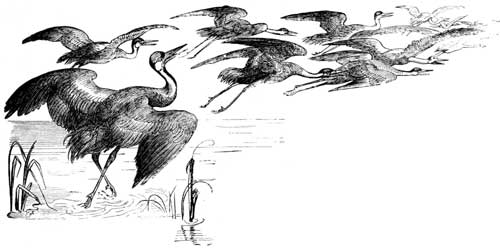
All text is available under the terms
of the GNU Free Documentation License
|